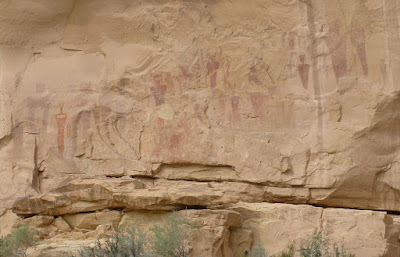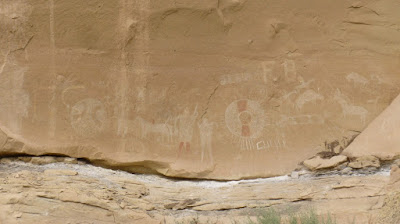About three miles north of Thompson Springs, Utah is an American Indian rock art site that includes both petroglyphs (made by etching the rock surface) and pictographs (made by painting the rock surface). You can take Utah State Route 94 north from Interstate 70. The numbered route ends just south of the town, but the road keeps going and eventually leads into a narrow canyon. On the left side of the road is a small parking area. This petroglyph panel is commonly attributed to the Fremont Culture, who lived in what is now central Utah from around 600 to 1250 AD, but whose origins go back further. Sadly, there are some non-Indian additions.
A large panel of pictographs is thought to have been made by Archaic people, who were in the area between 8,000 and 2,000 BC. While the Freemont, like their contemporaries the Anasazi, were agricultural, the earlier Archaic people were mainly nomadic hunter-gatherers. The style of these paintings is called Barrier Canyon Style.
Here are the pictographs from a different angle.
The most recent art was made by the Ute, and includes both petroglyphs and pictographs. Some of the figures depict horses, thus dating them from after the arrival of the Spanish, who introduced the horse into North America. Sadly, this panel also contains non-Indian additions. The Ute lived in the area from around 1,300 AD, and are still around today, largely on reservations.
The Sego Canyon rock art has been subjected to quite a bit of study and speculation. More about the figures can be found at Climb Utah, Science Views, Ancient Origins and Legends Of America.




No comments:
Post a Comment